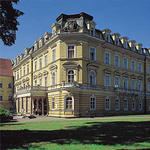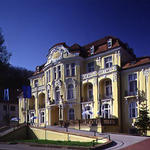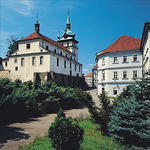
The whole district is characterised by three very distinctive areas: The Krusne Hory mountainous range in the North, the Brown Coal Basin at the centre and the Ceske Stredohori range in the southern part of the district. The major crossing with Germany that connects Prague with Dresden and Berlin is to this day located across theses mountains.
The district town of Teplice, which today is home to more than 53,000 people, is an historic spa town in the Podkrusnohori ("Under the Ore Mountains") Region. Teplice is the oldest spa in Bohemia.
The most valuable possession of the city is its
thermal Pravridlo ("Old Spring") spring, with a temperature of 42 Celsius and an output of 24,000 hectoliters per day. The name of the spring demonstrates how the healing effects of the hot water have been known even since ancient times. The beneficial effects of the water, which contains radon, have been used in treatments for more than eight centuries. Pravridlo has been endangered several times and even stopped gushing once, after the 1755 Lisbon earthquake.
The Teplice spa experienced its greatest boom during the first half of the nineteenth century, when it was sometimes called the "social salon of Europe." The beautiful Classical and Empire style spa buildings helped to attract the likes of Goethe, Beethoven, Paganini, Jungmann, Palacky, and Neruda.
Today the spa is used to help treat health problems of the locomotor and circulatory systems, as well as nerve diseases and psychological disorders. Tourists visiting this area can utilize

the thermal water in the swimming pool and the indoor city baths. The town chateau also houses an exhibition on the history of the spa.
Every year, a varied cultural program is prepared for the spa's guests and for tourists. A highlight is the annual
festival celebrating Ludwig von Beethoven that takes place in September and October.
Among the historical monuments of interest to tourists are: the chateau church (built in the sixteenth century in the pseudo-Gothic style and reconstructed between 1798-1806), the Church of St. John the Baptist (built in the Baroque style between 1700-1703, with interior tombs dating from between the sixteenth and eighteenth centuries), and the Teplice Chateau (constructed on the ruins of a Benedictine Order monastery which had a three-naved Roman basilica). Construction of the chateau began between 1585-1634 and it was subsequently reconstructed several times during the 18
th and 19
th centuries. Today the castle houses the regional museum that has environmental and spa collections, a history of Teplice, and
the Ludwig von Beethoven Commemorative Hall.
Tourists will certainly be pleased by a number of nice places in the Teplice area. We can recommend trips to Doubravka Hill and its castle ruins (of the Schlossberg Castle, built 1478-1483), Pisecnak and its astronomical observatory, and Komari hurka, which is a good jumping-off point for summer and winter recreational activities.



 Guide
Guide 





